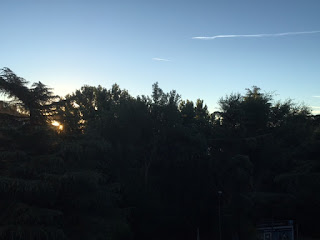In Madrid - studying and enjoying!
 It wasn’t
that bad sleep, but when your clock won’t turn immediately to local time, it
can be tough to wait for the breakfast and get some coffee! Before leaving
Finland many of my friends told me that I should enjoy Spain and Madrid while
this trip. Okay.. Where to start? I have one day off duty, my hotel is near few
golf courses (this I didn’t know before, no clubs with me), university area and
Centro Lescer the rehabilitation center. This is not the deepest City of Madrid,
but I try my best when the sun comes up!
It wasn’t
that bad sleep, but when your clock won’t turn immediately to local time, it
can be tough to wait for the breakfast and get some coffee! Before leaving
Finland many of my friends told me that I should enjoy Spain and Madrid while
this trip. Okay.. Where to start? I have one day off duty, my hotel is near few
golf courses (this I didn’t know before, no clubs with me), university area and
Centro Lescer the rehabilitation center. This is not the deepest City of Madrid,
but I try my best when the sun comes up!
But in the
early hours this morning I had time to read one article from Journal of Hand
Therapy. It was about neural plasticity and implications for hand
rehabilitation after neurological insult. It is known that the brain maintains
a capacity for functional and structural changes throughout life. Neuroplastic
changes occur in every structure in the entire neural axis and this gives
enormous possibilities and implications for rehabilitation after spinal, peripheral
or cortical injuries. It is still early to link the processes of brain
reorganization and specific rehabilitative approaches and outcomes, but it can
has exciting potential to combine these fields and help guide and improve
future treatment protocols. In the article you can learn about the mechanism of
plasticity, how the neural structures and function can change while training.
After some
specific information about Hebbian plasticity, synaptogenesis, dendritic
branching and even neurogenesis, there is a chapter about “pattern of motor map
reorganization”. Have you heard the principle “use it or lose it”? If you don’t
use your hand your cortical areas lose it from the map. This is what happens
after stroke or other neurological insult, or after some operation. You need to
relearn motor tasks afterwards. Of course we clinicians have the responsibility
to guide but also understand the potential to enhance plasticity and
behavioural relevance while recovery and rehabilitation.
Mapping and
reorganizing needs time. It seems to have more benefits with long-term practice
over several weeks to get more permanent changes than the transient short-term
changes observed over a single session.
In the end
of this article there was some point-of-views about CIT (constraint induced
therapy) and how it has worked with stroke patients. There has shown lots of
improvement with affected arm and hand functions and also neuroplasticity
changes with this method but still the causal effect is unknown. It presents
the CIT’s task specificity, practice intensity and also maladaptive and
age-related considerations. It is important to remember that principle of
training induced plasticity is that induced changes are specific to the
practiced task. A specific dosage about practice intensity to induce plastic
changes in humans is still lacking. And what comes to maladaptive
considerations, you need to find the balance with intensity. Otherwise it can
lead to detrimental consequences. And of course we need to notice the
age-related changes to brain.
“Understanding
neural plasticity and the potential benefit of training to alter brain
reorganization and associated motor function is utmost importance to hand
rehabilitation clinicians.”

 Now it’s
getting lighter here in Madrid and it’s time for breakfast! Coffee is not the
same as in Finland, but few cups Spanish coffee must have. Then out to the
streets, first I wanted to find Centro Lescer so it’s easier to start tomorrow.
One missed crossroad and you can walk a bit more. Anyway, it’s almost in the
neighbourhood (in the picture, behind the bushes).
Now it’s
getting lighter here in Madrid and it’s time for breakfast! Coffee is not the
same as in Finland, but few cups Spanish coffee must have. Then out to the
streets, first I wanted to find Centro Lescer so it’s easier to start tomorrow.
One missed crossroad and you can walk a bit more. Anyway, it’s almost in the
neighbourhood (in the picture, behind the bushes). 









Kommentit
Lähetä kommentti